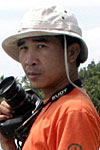|


|
| Jimmy A. Domingo |

A second take on the skills needed by photojournalists in future is provided by Jimmy A. Domingo, a freelance photographer and photojournalism program coordinator of the Asian Center for Journalism at the Ateneo de Manila University in the Philippines.
Says Jimmy: “If your pictures are not good enough, you are not close enough.”
This is attributed to the legendary photographer Robert Capa and it is a quote
I have been using lately to start discussions on what makes a skillful or a
complete photojournalist in this age of internet communication technologies.
Capa may not just have been referring to the physical closeness between a photographer
and his subjects. And this may hold truer in these times where a photojournalist
has more platforms to show (and sell) his works and the competition is becoming
stiffer.
What are the skills needed to get close in the various dimensions of a photography
project and, in effect, be an effective photojournalist?
All things being equal in terms of technical skills - understanding light, capturing
good quality images, achieving effective composition with a variety of lenses
and array of angles and knowing when to press the shutter - as ever the most
important skill is newsgathering.
And this involves a great deal of research to understand the subject being
photographed and how a particular subject matter has been approached visually
before.
We learn from the masters, from the role models of cutting-edge photojournalism.
However, there is an information overload on the web, much of which I call digital
garbage, and Internet research skill is a must. This is on top of good communication
on the Internet for getting assignments, being in touch with editors and swift
delivery of images.
With digital photography now being the norm - where one can only read generic
camera-generated alphanumeric filenames and the physical photograph is seen
only when it is opened - a proficiency in applying industry-standard metadata
is essential. Extend this skill to batch processing in software.
This will help give sufficient information about a particular image and provide
some copyright protection. I know a lot of photographers who have the required
images but take time to retrieve them from a hard disk due to lack of an archiving
system.
With the shrinking of print pages and more online platforms - where the huge
challenge now is how to hold the interest of viewers - skill in creating multimedia
presentations is vital.
Apart from still pictures, the inclusion of interviews in audio – making the
subjects “speak” and/or self-recorded material – gives context to a story. Software
like Soundslides can easily be learned for such presentations.
To get feedback on portfolios and ongoing projects, creating photojournalistic
blogs is an option. A domain name is not that expensive and there are hundreds
of free host sites with responsive content management systems.
On top of all this, an appreciation of the ethical issues in photojournalism
is fundamental. Especially now, when software can be used with so much ease
to modify images to the point of fakery and manipulation. The only safeguard
is for photojournalists to say No to the “everybody-is-doing-it-why-shouldn’t-I”
behavior.
Finally, whatever skills a photojournalist has must be shared with aspiring
visual story tellers. And acquiring teaching skills is another challenge but
it should come naturally to those who are willing to take on such a daunting
task."
|
|